Gouldian finch
The Gouldian finch (Chloebia gouldiae), also known as the Lady Gouldian finch, Gould's finch or the rainbow finch, is a colourful passerine bird that is native to Australia.
| Gouldian finch | |
|---|---|
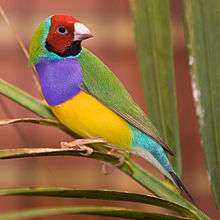 | |
| Adult red-headed male | |
| Scientific classification | |
| Kingdom: | Animalia |
| Phylum: | Chordata |
| Class: | Aves |
| Order: | Passeriformes |
| Family: | Estrildidae |
| Genus: | Chloebia Reichenbach, 1862 |
| Species: | C. gouldiae |
| Binomial name | |
| Chloebia gouldiae (Gould, 1844) | |
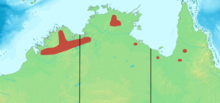 | |
| Distribution | |
| Synonyms[2] | |
|
Amadina gouldiae Gould, 1844 | |
Taxonomy
The Gouldian finch was described by British ornithological artist John Gould in 1844 as Amadina gouldiae,[2] in honour of his deceased wife Elizabeth.[3][4] It is also known as the rainbow finch, Gould's finch, or the Lady Gouldian finch and sometimes just Gould.[5] It is a member of the estrildid-finch family Estrildidae, which is sometimes considered a subfamily of Passeridae.
It has been placed in the genus Chloebia, as Chloebia gouldiae.[6]
Description
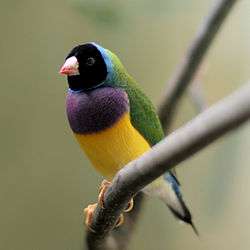
Both sexes are brightly coloured with black, green, yellow, and red markings. The females tend to be less brightly coloured. One major difference between the sexes is that the male's chest is purple, while the female's is a lighter mauve.[7]
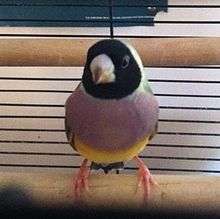
Gouldian finches are about 125–140 mm long.[8] Gouldian finches' heads may be red, black, or yellow. Formerly considered three different kinds of finches, it is now known that these are colour variants that exist in the wild.[9] Selective breeding has also developed mutations (blue, yellow and silver instead of a green back) in both body and breast colour.[10]
There are several "prominent rounded tubercles" with an "opalescent lustre" at the back of the gape. These tubercles are commonly (and incorrectly) described as phosphorescent in spite of much scientific evidence to the contrary.[11] It is believed that these tubercles simply reflect light and are not luminescent.[11]
Distribution and habitat
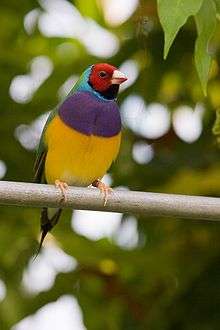
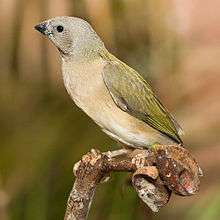
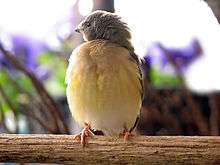
Prior to the Australian government's ban on the export of Australian fauna,[12] Gouldian finches were exported worldwide. These birds have resulted in viable breeding populations being held in many countries.
Captive breeding has resulted in several colour mutations.[13] Mutations vary by country, with some existing only in Australia (the Australian yellow and the Australian "dilute") and others existing in greater number in the United States, such as the blue bodied Gouldian. The most common body mutations in the United States are blue, pastel green (single and double-factor, resulting in "dilute" and yellow males and yellow females), and pastel blue (again, single and double-factor producing "pastel" and silver males, and silver hens).[14] There is also a lutino and albino mutation in the United States, established by Winnie McAlpin of Delmar Aviaries.[15]
Conservation status
The number of Gouldian finches has decreased quite dramatically during the 20th century. Their habitat has been reduced or altered. Early research indicated a parasite called the air sac mite was responsible for the decline of the species. This is no longer considered to be a major factor. In general, Gouldian finches are susceptible to diseases and viral infections. Their beautiful colours mean that they are easily caught by predators. Fires are listed as the primary threat to the natural populations.[16][17]
Behaviour
Outside the breeding season, Gouldian finches often join mixed flocks consisting of long-tailed finches and masked finches. Flocks can consist of up to 1,000–2,000 individuals.[18][19] During the breeding season, they are normally found on rough scree slopes where vegetation is sparse. In the dry season, they are much more nomadic and will move to wherever their food and water can be found.[19]
Feeding
.jpg)
Like other finches, the Gouldian finch is a seed eater. They eat up to 35% of their bodyweight each day.[20] During the breeding season, Gouldian finches mainly feed on ripe and half-ripe grass seeds of sorghum. During the dry season, they mainly forage on the ground for seeds. During the wet season, spinifex grass seed (Triodia sp.) is an important part of their diet. So far Gouldians have been recorded eating six different species of grass seed, but researchers have yet to find evidence of insect consumption.[21]
Breeding
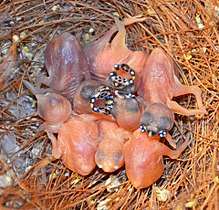
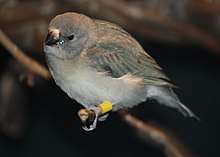
Gouldian finches will usually make their nests in tree-holes. They usually breed in the early part of the dry season, when there is plenty of food around.[22] When a male is courting a female, he bobs about and ruffles his feathers in an attempt to show off his bright colors. He will expand his chest and fluff out the feathers on his forehead. After mating, the female will lay a clutch of about 4–8 eggs. Both parents help brood the eggs during the daytime, and it is the female who stays on the eggs at night. When the eggs hatch, both parents care for the young. Gouldian finches leave the nest after between 19 and 23 days and are completely independent at 40 days old.[22]
Gouldian finches have brightly coloured gapes and call loudly when the parent birds return so that they are able to find and feed their mouths in the dark nest.[23]
It has been shown that female Gouldian finches from Northern Australia can control the sex of their offspring by choosing mates according to their head color. A certain amount of genetic incompatibility between black and red-headed birds can result in high mortality (up to 80%) in female offspring when birds of different head colours mate. If the female mates with a finch of different head colour, this genetic incompatibility can be addressed by over-producing sons, up to a ratio of four males to one female. This is one of the first proven instances of birds biasing the sex of their offspring to overcome genetic weaknesses.[24][25]
Aviculture
Gouldian finches are a popular species in aviculture because of their striking colors and, like all finches, they are also quite low maintenance.[22] Gouldian finches get along well with other species of grass finch and some other docile species of bird, such as waxbills and parrot finches.[26]
Trapping for aviculture
In the Kimberley District of Western Australia, where most wild Gouldian finch were trapped for aviculture, it was often reported as one of the more common of the eleven finch species. Until 1977, it was trapped in greater numbers than any other finch. From 1897, when finch trapping started in the Kimberley, it was the most sought after finch by trappers and the most desired by fanciers. Between the years 1934 and 1939, the Gouldian finch was the most exported single finch species. The Perth Zoo exported 22,064 finches of which 12,509 were Gouldian. Private dealers exported 35,315 finches, of which 14,504 were Gouldian. The number of finches taken in the 1958 finch trapping season was the largest for one year, of the 38,649 finches taken, 11,286 were Gouldian. The last licensed trapping of Gouldian finch in Western Australia was on 15 November 1981. In that year's finch trapping season, of the 23,450 finches taken 1,054 were Gouldian.[27] However, it is now illegal to export these birds from Australia.[28]
Gallery
Gouldian finch mutations
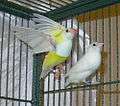 White Gouldian finch and yellow Gouldian finch mutation
White Gouldian finch and yellow Gouldian finch mutation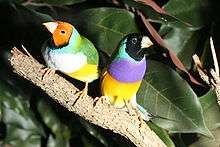 White-breasted yellow-headed Gouldian finch (left) and black-headed male Gouldian finches
White-breasted yellow-headed Gouldian finch (left) and black-headed male Gouldian finches Adult male double factor yellow back Gouldian finch
Adult male double factor yellow back Gouldian finch
References
- BirdLife International (2016). "Chloebia gouldiae". IUCN Red List of Threatened Species. 2016: e.T22719744A94642482. doi:10.2305/IUCN.UK.2016-3.RLTS.T22719744A94642482.en. Retrieved 10 January 2020.
- Australian Biological Resources Study (6 May 2016). "Species Erythrura (Chloebia) gouldiae (Gould, 1844)". Australian Faunal Directory. Canberra, Australian Capital Territory: Department of the Environment, Water, Heritage and the Arts, Australian Government. Retrieved 28 August 2018.
- "The Goulds, John Gould (1804–1881)". Avicultural Review. The Avicultural Society of New South Wales (ASNSW). 15 (1). January 1998.
- "Part 1: An introduction to the Gouldian finch – Planet Aviary". planetaviary.com. Retrieved 25 August 2018.
- "The Gouldian Finch – Chloebia gouldiae". www.efinch.com. Retrieved 27 August 2018.
- http://www.birds2u.info/characteristics_gouldian_finch.htm
- Arkive.org
- "Gouldian Finch Identification – Gouldian Finch". www.diamante-de-gould.com. Retrieved 26 August 2018.
- Southern H.N. (1945). "Polymorphism in Poephila gouldiae" (PDF). J. Genet. 47: 51–157. doi:10.1007/BF02989037.
- "Gouldian Finch colour mutations".
- McAtee W.L. (July 1947). "Luminosity in Birds". American Midland Naturalist. 38 (1): 207–213. doi:10.2307/2421636. JSTOR 2421636.
- "Department of the Environment and Energy". Department of the Environment and Energy. Retrieved 25 August 2018.
- "Gouldian Finch colour mutations | Finch Stuff". Finch Stuff. Retrieved 25 August 2018.
- Gouldian Body Color Genetics Archived 1 March 2013 at the Wayback Machine. Gouldiansgalore.com. Retrieved on 2013-08-30.
- Delmar Gouldian Finches – Home. Gfinches2.com. Retrieved on 2013-08-30.
- "Gouldian finch – WWF-Australia". Retrieved 25 August 2018.
- "Australian Wildlife Conservancy". www.australianwildlife.org. Retrieved 25 August 2018.
- "Gouldian Finch | Pets4Homes". Pets4Homes. Retrieved 30 August 2018.
- "Gouldian Finches or Rainbow Finches | Beauty of Birds". www.beautyofbirds.com. Retrieved 30 August 2018.
- "Lady Gouldian Finch Diet Feeding Guide". Retrieved 28 August 2018.
- "Gouldian Finches or Rainbow Finches | Beauty of Birds". www.beautyofbirds.com. Retrieved 28 August 2018.
- "8 Top Low-Maintenance Pet Bird Species".
- Attenbourgh, David. The Life of Birds, Episode 9, 3 mins, 55 s.
- Pryke, S.R.; Griffith, S.C. (2009). "Genetic incompatibility drives sex allocation and maternal investment in a polymorphic finch". Science. 323 (5921): 1605–1607. Bibcode:2009Sci...323.1605P. doi:10.1126/science.1168928. PMID 19299618.
- "Bird Controls Offspring's Gender". Scientific American.
- https://lafeber.com/pet-birds/species/lady-gouldian-finch/>
- Finch Trapping in the Kimberley, K H Coate and L H Merritt (2015) ISBN 978-0-85905-621-2 – ref Fisheries Department, table, trapped birds export statistics 1935–1939 22 August 1939, SROWA CONS 477, ITEM 1934-0059; and Department of Conservation and Land Management, table, Annual Finch Trapping Since 1968 1986. SROWA CONS 6437, ITEM 014832F3528
- "Department of the Environment and Energy". Department of the Environment and Energy. Retrieved 31 August 2018.
External links
| Wikimedia Commons has media related to Chloebia gouldiae. |
| Wikispecies has information related to Chloebia gouldiae |
